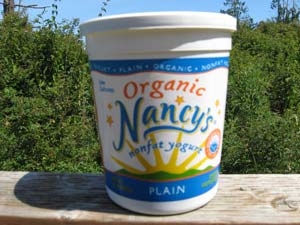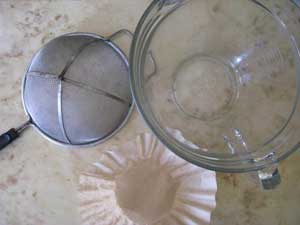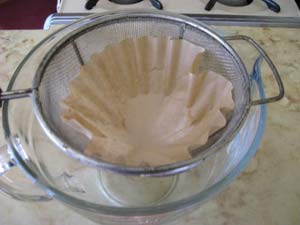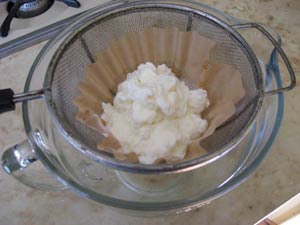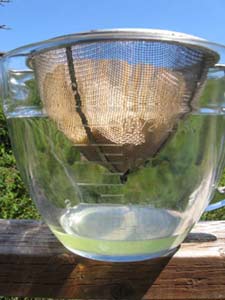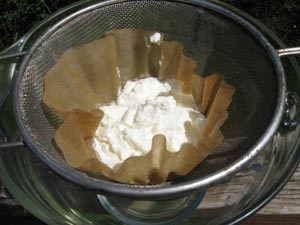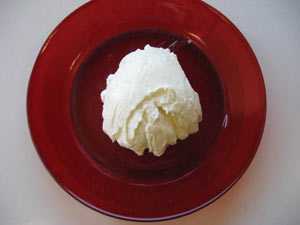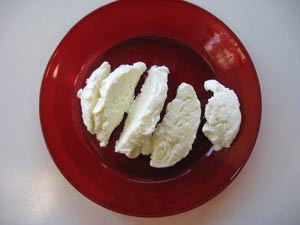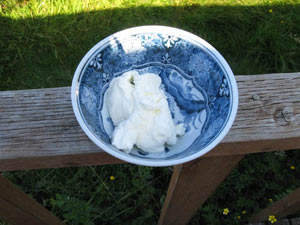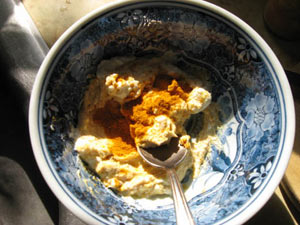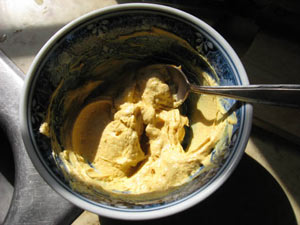I just finished typing up a recipe to send to the woman who’s in charge of programs for the new Snohomish Knitters Guild. I’ll give my “Knitting, S.E.X., Chocolate, and a Couple of Math Skills” class/presentation at their October 13 meeting. I’m responsible for the hand-outs. They’re responsible for the chocolate. They can provide it in any form, but I send along a few of my favorite recipes in case anyone is inclined to bake. Today I added my friend Marilyn’s Chocolate Zucchini Cake to the mix.
It occurred to me that since the zucchinis are starting their annual invasion of the northern hemisphere, you might enjoy having this recipe as well. Australian and South African readers can bookmark this for the time when the invading hordes migrate their way.
An introduction to cakes
Cakes are easy to make. Recipes . . . not always easy to read. So I streamlined the process by thinking about it differently. I know this is a long explanation, but once you have the process down, you can make a cake about 3 times faster than if you laboriously follow most recipes.
You have basically 3, maybe 4, categories that go into a cake:
- A bowl of dry ingredients.
- A bowl with the fat (butter or oil), sugar and eggs that you “cream together.”
- A liquid of some sort that’s usually not much so you can hold it in a measuring cup. (I use a one or two cup liquid measuring cup.)
- You might have some solid things like nuts to add in at the end.
When I lived with “the guys” (a couple of husbands and a son, not all at the same time) I baked lots of cakes. This was my procedure:
- The night before I was going to bake I’d put the dry ingredients into a two to three quart bowl. For almost every cake, these are the same: flour+salt+baking soda and/or baking powder. A few other powders that might be included are unsweetened cocoa for a chocolate cake and some spices like cinnamon and cloves for a pumpkin or carrot cake. Take a fork or a whisk and gently stir them together so that everything is evenly distributed. Be gentle but thorough. Always put love into your food during the preparation.
- Put the butter in a slightly larger bowl so that it can come to room temperature overnight. I’ve already referred to the fact that I’m over-the-top in love with Challenge Unsalted Butter. That’s what I use. The recipe calls for oleo or margarine? I use my beloved butter. I store it in the freezer because unsalted butter is more perishable than salted. It needs a while to reach temperature and I leave it in its wrapping until it’s time to “cream” it.
- Set out the number of eggs you’ll need. Put them in a bowl on the counter so that one doesn’t roll off and splat on the floor.
- Measure out the “wet” ingredients in a cup. It’s usually milk or buttermilk, occasionally water.
- Go to bed and get a good night’s rest. Your ingredients are adjusting to room temperature in preparation for their willing sacrifice to your palate.
Show Time!
The above part of the preparation was the Zen part of cake-baking, but when it’s time to put it all together you need to get on with it. Making a cake is an exercise in chemistry and once you start the next part of the process you need to move faster.
- Grease the pan(s) and turn on the oven, usually to 350º.
- Cream the butter. That means beat the heck out of it with an electric hand mixer (my tool of choice), full-sized mixer or wooden spoon. Using a spoon takes a lot of time and considerable arm strength, but I’ve done it. You’re getting the butter soft and incorporating air into it.
- Add the sugar a little at a time (about 4 different additions) to the butter and keep beating it. You’re fluffing it up some more.
- Add the eggs, one at a time, and beat after each addition. If the recipe calls for vanilla or some other extract I add it somewhere along in here.
Actually, you don’t have to hurry this creaming part. And this is the last time you’re allowed to “beat” anything vigorously. The reason is this: you don’t want your cakes to be tough. When you bake bread you knead the dough for a long time. This heavy treatment develops the gluten in the flour and that’s what gives bread it’s chewiness. It also helps to develop those good-sized holes.
Cakes are meant to be tender and you want to treat the addition of the flour mixture more carefully because you don’t want to develop the gluten.
You now have five additions to make to your creamed mixture. After each one you will stir/beat the ingredients just until they’re incorporated (i.e. you can’t see any more powdery stuff or loose liquid). They are:
- 1/3 of the dry ingredients
- 1/2 of the liquid ingredients
- 1/3 of the dry ingredients
- 1/2 (the rest of) the liquid
- 1/3 (the rest of) the dry ingredients
You don’t have to measure these exactly. Just eyeball them. And because now you’ve combined the baking powder and or baking soda with the liquid which often is acidic, you have a chemical reaction going on. The bubbles are starting to form and you want to get it in the oven soon.
Your last addition is any nuts, raisins or chocolate chips or other tasty morsels. Fold them in gently, trying to get them pretty evenly distributed but precision is not necessary for deliciousness.
Put the batter in the pan(s) and place the pan(s) in the oven and don’t you dare open that oven until more than half of suggested baking time has elapsed or even longer. Otherwise your cake might “fall.”
A few more miscellaneous details . . .
- Don’t do the jig in front of the oven or drop heavy things on it or jiggle the cake while it’s baking. Otherwise, your cake might fall (see above).
- When making a cake, measure your ingredients carefully. This is probably the only circumstance in which I do this because it’s chemistry (and alchemy but we won’t go there).
- If I use a 13″ x 9″ pan and I’m going to leave the cake in the pan after it’s cooled and cut the pieces out of there, I just grease the pan. If I use a pan (or pans) and want to take the cake out after about ten minutes of cooling, I grease the pans and then line the bottom with parchment paper I’ve cut to size. Waxed paper will do.
Finally!!! Marilyn’s Chocolate Zucchini Cake
Oh so moist. Not very sweet but definitely a heavy chocolate hit. And, of course, sinlessly good for you because of the zucchini.
Before you even turn on the oven or grease the pans, melt together in a small bowl in the microwave:
4 oz unsweetened chocolate
1/2 cup of neutral-tasting oil like canola
Be careful. Do it in one minute intervals and stir it in between them. The oil heats up quickly and the chocolate squares will continue to melt as you stir. You don’t want to scorch it. You will add this to the creamed ingredients after all the eggs are beaten in. Let this cool down before you add it to the fat ingredients because you do not want to melt your butter or cook your eggs!
The dry stuff:
1 Cup flour
1/3 C unsweetened cocoa (Droste or Equal Exchange Organic are good brands. Ixnay on the most common grocery store brand. It’s bitter and tastes burnt to me . . . chemical processing . . . not so tasty.)
2 t baking soda
2 t baking powder
1 t salt
The wet stuff:
1/3 C buttermilk or sour cream (if you don’t have them on hand you can use regular milk (any % fat or nonfat) with a teaspoon of lemon juice or vinegar added to it)
The cream together stuff:
1/2 C butter
2 C sugar (regular granulated, use something that says it’s pure cane sugar. There are issues with adulteration that you want to avoid.)
3 eggs
1 T vanilla
Add at the end fold in:
3 C grated zucchini or summer squash
1/2 to 1 C chopped walnuts
This is thicker than most cake batters but don’t worry.
Easiest is to bake in a 13″ x 9″ pan for about an hour or until it tests “done.” That’s when the edges are starting to come away from the pan and when you stick a toothpick into the middle of the cake, it comes out clean. If it’s not done it will come out with sticky batter on it. If you use smaller pans, like two 9″ round cake pans, you bake it for less time, like 40 minutes or so.
When it’s cool frost with Cream Cheese Frosting or any other favorite of yours.
Cream together 8 oz cream cheese and ½ cup soft butter (I prefer unsalted). Add 2 t of vanilla. Slowly add about 4 cups of confectioner’s sugar, beating with an electric mixer after each addition. (I usually don’t measure. Just keep adding sugar until it’s the right consistency and taste.)
A Disclaimer
Except for eighth grade Home Economics with Mrs. Blair I never studied cooking in a school. Instead, I learned to prepare food from a gaggle of mentors (mostly Ma, Grandma and Great Aunt Shirley) and by doing it. So be forewarned. I may not explain things in the “right” way, but
- I make food that people like to eat. Lots of it. Lots of them.
- No one has ever gotten sick from eating something from my kitchen. At least they haven’t told me about it if they have. Or maybe they haven’t lived to tell about it, but it’s likely I would have noticed their obituaries.

